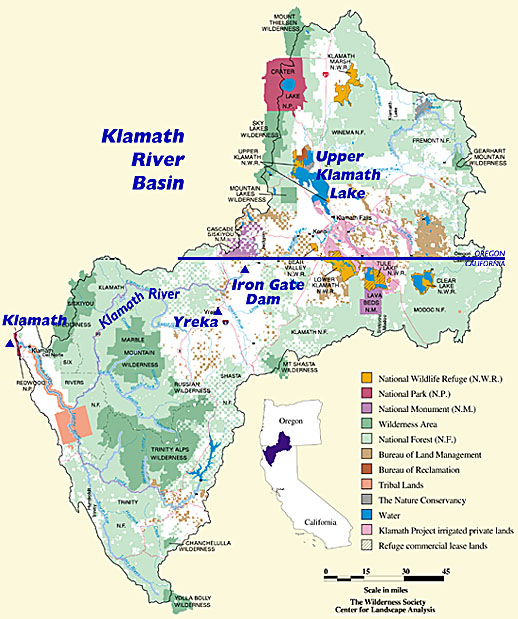Should agriculture take priority over maintaining stable river ecosystems and the water rights that tribal members have along the Klamath river?
http://www.westernrivers.org/projectatlas/blue-creek/
Kaylee Ardt
Natalie Selle
Solana King
Xander Cuizon Tice
The Klamath River
The Klamath River is a large body of water that flows through Oregon all the way to Northern California. The river supports an array of wildlife and is the most important resource for the people living along its banks. The Oregon Klamath River Basin has always been a hotbed of conflict over water rights. Like many places in the Western United States the Klamath River Basin faces difficult water management challenges. There is a wide variety of economic, political, geographical, and environmental issues that further complicate the matter. Agriculture and Tribal Rights are two of the leading topics barring this area from harmony.
Background: Conflict of Interest
There has long been agriculture along the Klamath River. Hundreds of private ranches lie above Upper Klamath Lake that source their irrigation for cattle from the rivers and streams that flow into the river. The Klamath, in fact, supports almost all of the irrigation to farmlands near and far from the river. At the dawn of the 20th century, Congress authrorized construction of the Klamath Project. This project was designed to store and channel spring water runoff in order to irrigate farms. The Basin, is also one of the poorest areas in the state and if the water were to disappear for these farmers, they’re livelihoods would be at stake.
There has also long been Tribes, such as the Klamath, Kuruk, and others, that have used this river as their main source for food and fresh drinking and cooking water. The Klamath, Modoc, and Yahooskin tribes ceded thousands of acres of land in 1864 when they signed a treaty with the federal government that guaranteed them fishing rights along Upper Klamath Lake. The Upper Klamath River supports endangered shortnose suckers and the Klamath River Tribes have claimed a right to maintain high water levels in Upper Klamath Lake to maintain this dying species. The salmon are considered sacred to the tribes and have deep roots in the tribes history and rituals. Downstream, there is a call for a greater release from Upper Klamath Lake by tribes and fisheries to support healthy salmon runs for Chinook and Coho Salmon as they travel upstream to lay their eggs.
What is the best option for the Oreon Klamath River basin?
A map of the Klamath River Basin

https://www.northcoastjournal.com/111303/cover1113-klamathmap.jpg
Works Cited:
Timmons, Daniel. Marten Law. Water Rights Settlements in Oregon’s Klamath Basin Facing Uncertain Future. Website. 2016
Peterson, Molly. KQED News. In The Klamath River Basin, Water Rights Are Personal. Website. 2016
Oregon.gov, https://www.oregon.gov/owrd/Pages/adj/index.aspx
NOAA FISHERIES,http://www.westcoast.fisheries.noaa.gov/klamath/
USDA, Klamath River Basin, https://www.nrcs.usda.gov/wps/portal/nrcs/detail/national/home/?cid=nrcs143_023523
NPR STAFF. NPR All Things Considered. Water Wars: Who Controls the Flow? Website. 15 June 2013.
Leslie, Jacques. Los Angeles Times. How a stunning Klamath Basin water agreement has been doomed by lawmakers. Website. 18 December 2015.
